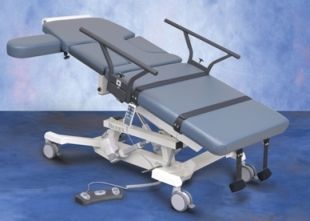Ergonomic Designs Make Imaging Workstations More Comfortable
Aching hands and a sore back are often familiar ailments for those working in a digital imaging department. However, there is a trend among radiology practices and hospitals to provide workstations that are far more comfortable.
Aching hands and a sore back are familiar ailments for many of those working in a digital imaging department. However, there is a trend among radiology practices and hospitals to provide workstations that are far more comfortable.
Over the past few years, industry vendors have taken great pains to produce ergonomically designed imaging tables and chairs and workstations. The goal is easing the physical stress of repetitive motions associated with performing and reviewing imaging tests, as well as chronic conditions such as carpal tunnel syndrome and tendonitis.
“There are some sonographers who suffer career-ending injuries because they don’t have comfortable workstations,” said Richard Schubert, product manager of imaging tables at design company Biodex.
Do you use an ergonomic workstation?
In a 2008 study published in the Journal of the American College of Radiology, Phillip Boiselle, MD, reported 58 percent of radiologists at Beth Israel Deaconess Medical Center experienced repetitive stress injury symptoms associated with their work. The study also determined 70 percent saw symptom improvements after using an ergonomic chair, and 80 percent had the same experience after switching to an ergonomic workstation.
“Repetitive stress symptoms are highly prevalent among radiologists working in a PACS-based environment but are responsive to ergonomic interventions,” Boiselle and his colleagues wrote. “Radiology departments should implement ergonomic initiatives to reduce the risk for repetitive stress injuries.”
Workstation equipment advancements include adjustable-height tables and chairs. Some table designs bring you closer to the patient, reducing the distance you must reach. Almost all equipment can accommodate right-handed and left-handed people, sitting or standing, and people of varying heights.
If your practice switches to ergonomic equipment, you could feel a boost in physical comfort, said Duncan Rougier-Chapman, MD, co-director of breast MRI and screening at Wake Radiology in Cary, N.C. The practice installed ergonomic workstations from Biomorph two years ago. The tables are height-adjustable, bringing arms and eyes in-line with the computer screen.

“Prior to using this equipment, I and many of my colleagues were in significant pain during the day,” he said. “If you do the same thing for 10 hours a day, you can get to the point where you can’t touch your wrists or fingers.”
Any pain can negatively impact your attention to detail, he said. Even the slightest distraction that causes you to miss minute details could be catastrophic for your patients.
If your practice doesn’t have ergonomic equipment, Boiselle recommended measures to limit the discomfort you feel during work hours. Flexing your hands before work, rotating your wrists, and taking frequent breaks can help you avoid injury from repetitive actions. Find a mouse with a contoured design that best fits your needs, and, if you can, alternate which hand uses the mouse. Use keyboard shortcuts to eliminate the need to move the mouse, and consider alternate input methods, such as speech recognition, to limit the wear on your hands.
The Reading Room: Artificial Intelligence: What RSNA 2020 Offered, and What 2021 Could Bring
December 5th 2020Nina Kottler, M.D., chief medical officer of AI at Radiology Partners, discusses, during RSNA 2020, what new developments the annual meeting provided about these technologies, sessions to access, and what to expect in the coming year.
Strategies to Reduce Disparities in Interventional Radiology Care
March 19th 2025In order to help address the geographic, racial, and socioeconomic barriers that limit patient access to interventional radiology (IR) care, these authors recommend a variety of measures ranging from increased patient and physician awareness of IR to mobile IR clinics and improved understanding of social determinants of health.